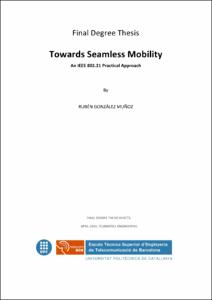Mostra el registre d'ítem simple
Towards Seamless Mobility: An IEEE 802.21 Practical Approach
| dc.contributor | Paradells Aspas, Josep |
| dc.contributor.author | González Muñoz, Rubén |
| dc.contributor.other | Universitat Politècnica de Catalunya. Departament d'Enginyeria Telemàtica |
| dc.date.accessioned | 2010-10-19T11:53:47Z |
| dc.date.available | 2010-10-19T11:53:47Z |
| dc.date.issued | 2010-04 |
| dc.identifier.uri | http://hdl.handle.net/2099.1/9927 |
| dc.description.abstract | In the recent years, mobile devices such as cell phones, notebook or ultra mobile computers and videogame consoles are experiencing an impressive evolution in terms of hardware and software possibilities. Elements such a wideband Internet connection allows a broad range of possibilities for creative developers. Many of these possibilities can include applications requiring continuity of service when the user moves form a coverage area to another. Nowadays, mobile devices are equipped with one or more radio interfaces such as GSM, UMTS, WiMax or Wi‐ Fi. Many of these technologies are ready to allow transparent roaming within their own coverage areas, but they are not ready to handle a service transfer between different technologies. In order to find a solution to this issue, the IEEE has developed a standard known as Media Independent Handover (MIH) Services with the aim of easing seamless mobility between these technologies. The present work has been centered in developing a system capable to enable a service of mobility under the terms specified in the stated standard. The development of a platform aiming to provide service continuity is mandatory, being a cross‐layer solution based in elements from link and network layers supplying a transparent roaming mechanism from user’s point of view. Two applications have been implemented in C/C++ language under a Linux environment. One application is designed to work within a mobile device, and the other one in the network access point. The mobile device basically consists in a notebook equipped with two Wi‐Fi interfaces, which is not a common feature in commercial devices, allowing seamless communication transfers aided by the application. Network access points are computers equipped with a Wi‐Fi interface and configured to provide Internet wireless access and services of mobility. In order to test the operation, a test‐bed has been implemented. It consists on a pair of access points connected through a network and placed within partially overlapped coverage areas, and a mobile device, all of them properly set. The mobile detects the networks that are compatible and gets attached to the one that provides better conditions for the demanded service. When the service degrades up to certain level, the mobile transfers the communication to the other access point, which offers better service conditions. Finally, in order to check if the changes have been done properly, the duration of the required actions has been measured, as well as the data that can have been lost or buffered meanwhile. The result is a MIH‐alike system working in a proper way. The discovery and selection of a destination network is correct and is done before the old connection gets too degraded, providing seamless mobility. The measured latencies and packet losses are affordable in terms of MIH protocol, but require future work improvements in terms of network protocols that have not been considered under the scope of this work. |
| dc.language.iso | eng |
| dc.publisher | Universitat Politècnica de Catalunya |
| dc.rights | Attribution-NonCommercial-NoDerivs 3.0 Spain |
| dc.rights.uri | http://creativecommons.org/licenses/by-nc-nd/3.0/es/ |
| dc.subject | Àrees temàtiques de la UPC::Enginyeria de la telecomunicació::Radiocomunicació i exploració electromagnètica::Comunicacions mòbils |
| dc.subject.lcsh | Wireless LANs |
| dc.subject.other | IEEE 802.21 |
| dc.title | Towards Seamless Mobility: An IEEE 802.21 Practical Approach |
| dc.type | Master thesis (pre-Bologna period) |
| dc.subject.lemac | Xarxes locals sense fil Wi-Fi |
| dc.rights.access | Open Access |
| dc.audience.educationlevel | Estudis de primer/segon cicle |
| dc.audience.mediator | Escola Tècnica Superior d'Enginyeria de Telecomunicació de Barcelona |
| dc.audience.degree | ENGINYERIA DE TELECOMUNICACIÓ (Pla 1992) |


